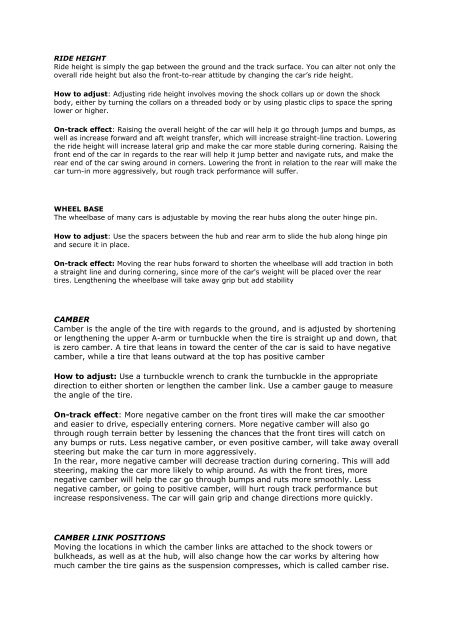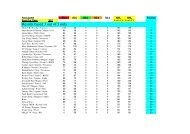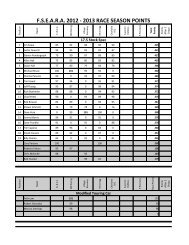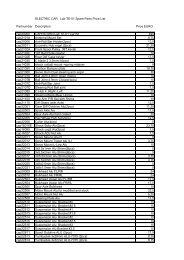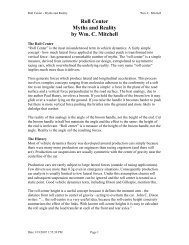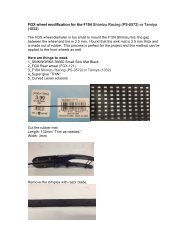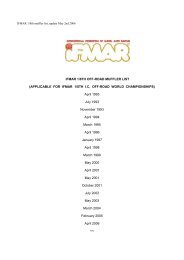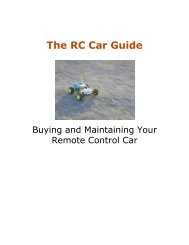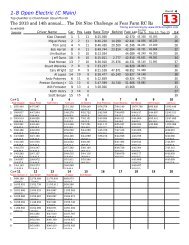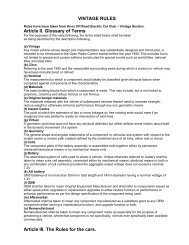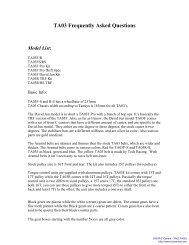You also want an ePaper? Increase the reach of your titles
YUMPU automatically turns print PDFs into web optimized ePapers that Google loves.
RIDE HEIGHTRide height is simply the gap between the ground and the track surface. You can alter not only theoverall ride height but also the front-to-rear attitude by changing the car’s ride height.How to adjust: Adjusting ride height involves moving the shock collars up or down the shockbody, either by turning the collars on a threaded body or by using plastic clips to space the springlower or higher.On-track effect: Raising the overall height of the car will help it go through jumps and bumps, aswell as increase forward and aft weight transfer, which will increase straight-line traction. Loweringthe ride height will increase lateral grip and make the car more stable during cornering. Raising thefront end of the car in regards to the rear will help it jump better and navigate ruts, and make therear end of the car swing around in corners. Lowering the front in relation to the rear will make thecar turn-in more aggressively, but rough track performance will suffer.WHEEL BASEThe wheelbase of many cars is adjustable by moving the rear hubs along the outer hinge pin.How to adjust: Use the spacers between the hub and rear arm to slide the hub along hinge pinand secure it in place.On-track effect: Moving the rear hubs forward to shorten the wheelbase will add traction in botha straight line and during cornering, since more of the car's weight will be placed over the reartires. Lengthening the wheelbase will take away grip but add stabilityCAMBE<strong>RC</strong>amber is the angle of the tire with regards to the ground, and is adjusted by shorteningor lengthening the upper A-arm or turnbuckle when the tire is straight up and down, thatis zero camber. A tire that leans in toward the center of the car is said to have negativecamber, while a tire that leans outward at the top has positive camberHow to adjust: Use a turnbuckle wrench to crank the turnbuckle in the appropriatedirection to either shorten or lengthen the camber link. Use a camber gauge to measurethe angle of the tire.On-track effect: More negative camber on the front tires will make the car smootherand easier to drive, especially entering corners. More negative camber will also gothrough rough terrain better by lessening the chances that the front tires will catch onany bumps or ruts. Less negative camber, or even positive camber, will take away overallsteering but make the car turn in more aggressively.In the rear, more negative camber will decrease traction during cornering. This will addsteering, making the car more likely to whip around. As with the front tires, morenegative camber will help the car go through bumps and ruts more smoothly. Lessnegative camber, or going to positive camber, will hurt rough track performance butincrease responsiveness. The car will gain grip and change directions more quickly.CAMBER LINK POSITIONSMoving the locations in which the camber links are attached to the shock towers orbulkheads, as well as at the hub, will also change how the car works by altering howmuch camber the tire gains as the suspension compresses, which is called camber rise.
How to adjust: Use the appropriate tools to remove the camber link from its currentlocation and replace in another. Use a camber gauge to adjust the angle of the tire backto its original camber measurement to ensure that you're only making one change at atime.On-track effect: By moving the front camber link to a shorter location on the frontsteering block, the tire will have more camber gain and smoother turn-in while havingmore steering through the middle and exit of the corner. On the shock tower, raising thelink to a higher location will make the car stay more flat, smoothing out the car's steeringresponse and making it easier to drive. A lower location will add body roll and moreaggressive steering.In the rear, moving the link to a shorter location on either the hub or shock tower willagain add camber rise, as well as more traction and rough-track performance. The longerlink offers less camber rise and body roll. Moving the link up higher on the rear shocktower will eliminate body roll and is a good adjustment to make on a smooth track withlots of grip. Lowering the link will add camber rise and make the car more forgiving whenthe track is rough.TOE-IN/TOE-OUTToe-in and toe-out is the angle of the tires compared to the centerline of the car. Tiresthat are pigeon-toed, or pointing inward, have toe-in. Tires that point outward are said tohave toe-out.How to adjust: Adjusting front toe angles again requires using the turn- buckle wrenchto lengthen or shorten the steering tie-rods equally on both sides; shortening the link willadd toe- out, while lengthening the link willincrease toe-in. For some cars (usually on-road), rear toe is adjusted in the samefashion, while most require changing pivot blocks, suspension bushings, or rear hubs tochange the angle of the tire.On-track effect: Front toe-in will increase initial steering response, while front toe-outwill make the car smoother and easier to drive, as well as increasing low-speed steering.More rear toe-in will add both straight-line and lateral traction. Less rear toe-in meansless grip, but it will go through rough sections better. Rear toe-out is never used.CASTE<strong>RC</strong>aster is the relation of the kingpin, or the point around which the steering knucklerotates, in relation to theground. Positive caster means that the kingpin is leaning rearward: this is easy to see onall off-road cars.How to adjust: Some 1/8-scale buggie and trucks use clips on the upper, inner hingepin to slide the upper A-arm forward or rearward. Otherwise, most cars require changingthe front steering knuckle or caster block to change the caster angle.On-track effect: More caster will decrease turn-in while increasing exit steering. Morecaster will also go through ruts better. Less caster adds steering into the corner anddecreases steering through the rest of the corner.ANTI-SQUATAnti-squat is the angle of the rear inner hinge pins in relation to the ground. When the
front of the pin is higher than the rear, the car has anti-squat. If the rear of the pin ishigher than the front, it has pro-squat. pro-squat is not used.How to adjust: Adjusting anti-squat requires disassembly you’ll either need to changethe pivot blocks, or add or remove spacers underneath the pivot blocks In order tochange the angle of the pen.On-track effect: Increasing anti-squat will add on- power steering, straight-linetraction. and make the car jump higher. Decreasing anti-squat will decrease on-powersteering, increase lateral traction. and make the car stay lower over jumps.SHOCK POSITIONSAltering the locations in which the shocks are fastened to the shock towers andsuspension arms will change the leverage the tires have on the shocks as would as therate at which the shock progressively gets stiffer as it compresses.How to adjust. Like changing camber link locations, you’ll have to remove the shockfrom either the tower or the arm and reattach it in a different spot.On-track effect: Moving the shock inward on the tower will make the shock moreprogressive, adding body roll and overall grip as the shock will be softer initially. Goingout on the tower will make the shock feel more linear, as well as tree up the car, reducebody roll, and make it jump better. on the arm, moving inward will make the car feelsofter and less stable, but will handle a rough track more smoothly. Moving further outon the arm will make the car feel more stable as well as rotate more during cornering.SHOCK OIL AND PISTONSSilicone oil is used inside the shock body to provide dampening. The oil is forced throughthe holes In the shock piston to slow the action of the shock when hitting surfacechanges.How to adjust: To change oil or pistons, you’ll have to disassemble the shock and rebleedaccording to instructions.On track effect: Thicker shock oil will handle larger bumps and jumps and be moreconsistent in hotter weather. Likewise, thinner oil will soak up smaller bumps better andwork best in cold weather. shock pistons with larger holes are best saved for tracks withfewer pimps, while smaller pistons are good for tracks littered with ramps and gaps sincethey will slow the shock down.SHOCK SPRINGSIt’s pretty easy to tell what the shock spring does; they provide cushion when the carhits a jump or bump. and extend the shock after compression.How to adjust: The disassembly required to change springs is a piece of cake; removethe bottom af the shock from the shaft. sliue the spring off of the ahosk and replace.On-track effect: Slitter springs will make the shock rebound more quickly, helping thecar jump better and absorb big bumps that are take at speed. Shorter springs slow downthe shock’s location making the car easier to drive abeit more lazy.


